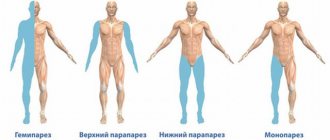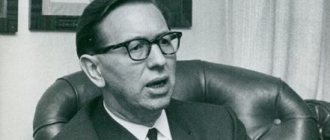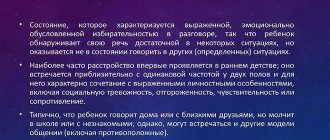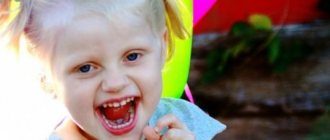Torsion dystonia affects an average of 3 people per 100,000 population.
Typically, the first symptoms of the disease appear at a young age: up to 20 or even 15 years, and then the disease progresses, at times interrupted by remissions and exacerbating with renewed vigor.
Torsion dystonia can be either a side effect of other diseases (brain cancer, encephalitis, cerebral palsy, etc.) or an independent hereditary disease. In the first case, the disease is called symptomatic torsion dystonia, and in the second - familial.
What is torsion dystonia
Torsion dystonia is a neurological disease with a high degree of progression, characterized by the presence of uncontrolled tonic contractions of various muscle groups, which leads to the development of pathological postures. This disease can provoke curvature of the spine and joint contractures. Torsion dystonia occurs equally in adults and children, regardless of gender.
- Etiology
- Classification
- Symptoms
- Diagnostics
- Treatment
- Possible complications
Pathology is diagnosed after a medical examination and exclusion of other diseases. For differentiation, instrumental studies are used: REG, USDG of the vessels of the head, EEG, EchoEG, CT and MRI of the head.
Therapeutic measures will depend on the cause of the disease and the severity of the patient's condition. Conservative treatment is most often used; in cases of disability, surgical intervention is used.
Modern neurology uses methods to stabilize the patient's condition and restore the ability to self-care. The therapeutic prognosis depends on the type of muscle deviation.
Pathogenesis and clinical manifestations
Direct torsion dystonia develops as a result of a disturbance in the metabolism of the neurotransmitter dopamine in the extrapyramidal system of the brain (subcortical motor center). In this case, two forms arise - dopamine-dependent (rigid) and dopamine-independent (hyperkinetic). This is a very important point, since the treatment will vary for different forms. It is also known that the autosomal dominant variant is milder than the autosomal recessive variant.
An important sign of torsion dystonia is its gradual development. Initially, the patient complains of small rotational spasms in various parts of the body, most often on the extremities (especially the lower ones). This usually occurs on one side of the body. In this case, difficulties with walking very often arise.
Subsequently, such corkscrew-like spasms begin to appear much more often in other parts of the body. This is the so-called local form. It can become generalized, in which large muscle groups are involved. Symptoms intensify if the patient tries to concentrate and make the right movement. During sleep, symptoms of the disease usually disappear.
If the hyperkinetic form is characterized by clonic convulsions (i.e., muscle contraction is followed by its relaxation), then with the rigid form spastic ones develop (convulsions in which the muscles are tense for a long time). In this case, fixed pathological postures arise, both in local areas and in the entire body.
With the further development of torsion dystonia, complications such as writer's cramp, contractures, joint deformation, curvature of the spine and torticollis appear. The gait changes, and disturbances in speech, chewing, swallowing, and breathing may occur. Due to the constant load on the muscles, their hypertrophy occurs.
The above etiofactors cause dysfunction of the multi-level system for regulating muscle tension. The result is spontaneous impulses that over-activate certain muscles. The activated muscle group enters a state of tonic contraction, which leads to violent movement followed by freezing.
Depending on the location of the muscle group subject to pathological impulses, involuntary turning of the head, twisting of the body, squinting of the eye, dystonic trismus, etc. are possible. The alternation of excessive tension of antagonist muscles underlies hyperkinesis - involuntary motor acts of varying amplitude and speed. The pathogenetic mechanism of development of many MD continues to be studied.
Causes of torsion dystonia
Torsion dystonia (TD) is a chronic pathology of the nervous system, which causes involuntary tonic muscle twisting. In 65%, the disease manifests itself before adolescence, the average for a certain population is about 40 patients per 100,000 population.
The causes and pathogenesis of the pathology are currently poorly understood. The main factors that can trigger muscle torsion are:
- hereditary predisposition;
- abnormalities in the functioning of the central nervous system due to inflammation;
- problems with the functioning of cerebral vessels;
- intoxication;
- hemorrhage;
- cerebral infarction;
- malignant or benign brain tumors;
- postpartum skull injuries.
All patients had metabolic disorders with high levels of dopamine (a neurotransmitter that plays an important role in brain activity). Dopamine performs not only the function of an intermediary in the transmission of neurons to the central nervous system, but also the function of a hormone that protects the gastrointestinal tract from damage by digestive enzymes.
Symptomatic manifestations of TD are observed in the following diseases:
- cerebral palsy (CP) is a group of chronic symptom complexes of motor disorders secondary to brain damage or abnormalities;
- Huntington's chorea is a genetic disease of the nervous system, most common in people aged 30–50 years;
- Wilson's disease is a hereditary pathology associated with a gene mutation that causes the accumulation of copper in various organs and tissues;
- Parkinson's disease is a degenerative disorder of the motor system that progresses slowly and causes the death of neurons, manifesting itself after 50 years;
- epidemic encephalitis - inflammation of the brain substance.
Muscle twisting can also be observed as a reaction to long-term use of antipsychotic drugs. It is important to follow medical recommendations and not exceed the dosage of the drug.
General information
Muscle tension (tone) is necessary to maintain body posture and perform movements. In contrast to decreased (hypotonicity) and increased (hypertonicity) muscle tension, muscular dystonia (MD) indicates a violation of the adequate balance of tone of individual muscles or muscle groups. MD is not a nosological entity; it is a syndrome that occurs with various lesions of the central nervous system.
According to European studies, muscular dystonia occurs in Western European countries with a frequency of 11.2 cases per 100 thousand population. The onset of manifestations is possible at any age. An earlier onset of symptoms leads to more rapid progression of the syndrome with subsequent generalization of the process.
Muscular dystonia
Classification
Torsion dystonia is a common disease, reflected in the World Classification of Diseases, according to ICD-10 it has the code G20-G26.
In modern medicine, it is customary to distinguish the gradation of the disease according to various principles.
By age characteristics:
- infant group - up to 2 years;
- children's group - 3–12 years old;
- teenage – 13–20 years;
- dystonia of early age - 21–40 years;
- dystonia of older age - after 40 years.
According to the anatomical distribution, the following types of dystonia are distinguished:
- focal - a specific area of the body is captured (head, neck, facial muscles, torso, upper and lower limbs, vocal cords);
- segmental form - characterized by the involvement of two or more adjacent parts of the body (head and neck, neck and arm);
- multifocal - involves more than two non-adjacent parts of the body (face and leg, arm and leg);
- generalized - manifested by the involvement of both legs or torso, one lower limb and torso;
- hemidystonia - the process involves the muscles of half the torso, face and neck, which often indicates a secondary condition.
According to the pathoanatomical principle:
- with degeneration, when there is a disappearance of certain functional features of the muscular system and muscle group;
- without degeneration - the damage is static.
According to etiological criteria:
- Primary. Diagnosed when muscle twisting is the only symptom. They occur for a genetic reason. There are two forms: local and generalized (uncontrolled tonic contractions of the muscles of the whole body).
- Dystonia-plus. This group includes cases with severe dystonic syndrome, which is supplemented by concomitant symptoms (paroxysm or myoclonus), but without degeneration.
- Neurodegenerative. Hereditary diseases (Wilson's disease and others) with a progressive process of degeneration.
- Secondary. They are characterized by a sudden condition with an established cause; there is no degeneration of functions.
The genetic classification includes a large number of gene mutations and is hereditary in nature, transmitted in an autosomal recessive or autosomal dominant manner. This form has a second name - idiopathic torsion dystonia, and is characterized by slow progression.
At the diagnostic stage, the doctor differentiates the disease, determines its type and severity.
Writer's cramp (writer's cramp, graphospasm)
Writer's cramp is an occupational dystonia. This is the most common form of local tonic spasm and occurs in the muscles of the hand, usually during writing. The cramp usually appears first in the fingers and then spreads in the proximal direction; it may be accompanied by pain, sometimes the occurrence of tremor and myoclonus in the same hand.
The disease most often occurs between the ages of 20 and 40 years. Among the patients, people who have to write a lot predominate. The frequency of writer's cramp among employees of institutions is 5.4 per 1000. Doctors, teachers, and journalists get sick even more often. Family cases of the disease have been described, indicating a possible hereditary transmission of predisposition to this disease. It is known that writer's cramp occurred among ancient Chinese scribes. It was described by de Grado in 1470. US President Woodrow Wilson had a writer's cramp.
During the treatment process, midocalm, tizanidine, or sirdalud, baclofen are prescribed, as well as physiotherapy affecting the peripheral neuromotor apparatus (heat, massage, paraffin, mud, ozokerite, dimexide, galvanization - anode on the neck, cathode on the arm, hydrocortisone phonophoresis); in cases of carpal tunnel syndrome - nerve decompression. Sometimes it is advisable to learn to write with the other hand, to become familiar with a typewriter or computer. In the treatment of all forms of dystonic syndromes, sedatives and benzodiazepines are indicated.
Symptom of torsion dystonia
Consecutive phases of torsion dystonia photo.
Symptoms of torsion dystonia are observed in most cases when there is a load on those muscles that undergo contraction.
Main features:
- involuntary twisting of a muscle group;
- rotational movements of the torso or limbs;
- corkscrew-like movement of the body;
- hyperkinesis of the limbs during an attempt to perform a purposeful action;
- there is sleep disturbance;
- During complete rest (night sleep) there are no symptoms.
Additional signs will appear if the form of the disease is not primary. The disease may not be detected immediately, but after a year or even five years, when the symptoms are clearly visualized.
Establishing diagnosis
When seeking help from a doctor, the first thing he pays attention to is: rigidity of muscle groups, which may result in reflexivity, decreased sensitivity and muscle strength, and decreased intelligence.
The diagnosis is based on the clinical picture, and if there are people in the family with the same disease, there is no doubt. The main methods for diagnosing torsion dystonia include:
Timely diagnosis will allow you to quickly make a correct diagnosis and begin adequate treatment.
Diagnostics
Diagnosis of torsion dystonia takes place in several stages:
- medical examination, listening to patient complaints and studying medical history;
- performing differentiation from secondary symptomatic manifestations;
- instrumental examinations.
Hardware diagnostics include:
- REG;
- Doppler ultrasound of cerebral vessels;
- EEG;
- EchoEG;
- CT;
- MRI of the head.
Based on the examination results, the specialist makes a final diagnosis and prescribes individual therapy.
Treatment of torsion dystonia
Treatment of torsion dystonia is conservative. The patient is prescribed the following medications:
- anticholinergics are broad-spectrum drugs that are applicable for all forms of pathology;
- muscle relaxants - help reduce the tone of skeletal muscles and reduce motor activity;
- benzodiazepines - drugs in this group have hypnotic, sedative, anxiolytic and anticonvulsant effects;
- botulinum toxin injections - used for local varieties of the disease;
- intrathecal administration of Baclofen - applicable for severe generalized dystonia of a secondary nature;
- chronic brain stimulation - used for primary forms with generalization.
Therapeutic exercises and hydrotherapy are mandatory. Therapy for secondary forms is aimed at eliminating the cause of the disease.
Muscular dystonia can lead to disability; in this case, surgical treatment is prescribed. The neurosurgeon performs stereotactic combined destruction of the basal subcortical structures. In 80% of patients after surgical procedures, significant improvement is noticeable, of which in 66% the improvement has a long duration.
Blepharospasm
Blepharospasm is a spastic contraction of the orbicularis oculi muscle, usually accompanied by intense tonic or tonic-clonic closure of the eyelids - a local manifestation of muscular dystonia. It can be an independent form of pathology - essential blepharospasm, which manifests itself more often at the age of 40-50 years; Reflex blepharospasm is also possible, which more often occurs with ocular pathology, hysterical and symptomatic blepharospasm, observed, in particular, with facial hemispasm and facial paraspasm. Blepharospasm and other forms of spasms of facial muscles, sometimes in the form of pathological synkinesis, can occur with Hallerwarden-Spatz syndrome, foci of demyelination in the brain stem, carbon monoxide poisoning, and an overdose of antipsychotics. Blepharospasm can be combined with dystonia of other facial muscles, as well as masticatory muscles, muscles of the tongue, larynx, and neck. It intensifies in bright light and excitement.
For blepharospasm, clonazepam at a dose of 4-6 mg/day is indicated, as well as Eglonil or Sanopax, sedatives, butyrophenones, and phenibut.
Treatment with botulinum toxin injections into the muscles surrounding the eyeball is also possible. Botulinum toxin has been used since 1981 in the form of Botox (USA) and Dysport (UK) to treat muscle spasms. For focal dystonia, Botox is injected into tense muscles, the effect appears after 4-14 days and lasts up to 3-6 months. Currently, botulinum toxin injections are considered by many to be the best way to symptomatically treat focal dystonia. In addition to blepharospasm, it is used in the treatment of oromandibular dystonia, spasmodic torticollis, writer's spasm, facial hemi- and paraspasm. Its widespread use is limited by the high cost of the drug.
For blepharospasm and facial paraspasm, it is advisable to wear dark glasses.
Possible complications
Torsion dystonia can lead to muscle hypertrophy: they lose flexibility and stretchability, which leads to their shortening. With prolonged twisting of muscle structures under the influence of spasm, degenerative processes occur in the joints.
Main consequences:
- joint contracture;
- rachiocampsis;
- lumbar lordosis;
- scoliosis;
- kyphoscoliosis;
- respiratory disorders;
- disability.
It is important to conduct a qualitative examination at the first uncharacteristic twitching or twisting of muscles in a child. The sooner treatment begins, the greater the chance of preventing disability.
Electrical stimulation of subcortical structures
Electrical stimulation of product structures is a new technique that implies that electrodes producing electrical discharges are implanted in the place responsible for painful impulses. Such signals suppress the activity of the inflamed area of the brain.
Surgery is also performed using stereotactic guidance techniques. After identifying the coordinates of the location of the target structure, the doctor conducts surgical access for intraoperative X-ray examination and fixes the electrodes in the subcortical areas.
The neurostimulator, which produces impulses, is made in the form of a small device that is implanted into the subcutaneous fat in the area under the collarbone. After surgery, electrical discharges are transmitted to the patient's brain. A person can independently control the functioning of the neurostimulator, taking into account his or her well-being.
During surgical treatment, destructive stereotactic procedures are performed, aimed at deforming the brain structures in which painful impulses arise. Initially, a stereotactic frame is fixed on the patient’s head. Then it is carried out.
After this, using special calculations using tomograms and stereotaxic landmarks, the coordinates of the target structure are determined. The doctor accesses the required part of the central nervous system and cuts off problem areas of the brain using different methods.
What to do?
If you think you have torsion dystonia
and symptoms characteristic of this disease, then a neurologist can help you.
We wish everyone good health!
Diseases with similar symptoms
Rhinopharyngitis (overlapping symptoms: 1 of 5)
Rhinopharyngitis is an inflammation that forms in the mucous membrane of the nose and pharynx. This disease is similar to two similar diseases that are concentrated in this area, namely pharyngitis and rhinitis.
In other words, nasopharyngitis is a complication resulting from acute rhinitis, in which the pharyngeal mucosa becomes inflamed, which also makes complaints about pain that occurs when swallowing relevant.
In turn, the pharynx becomes reddened, and its mucous membrane becomes thickened, becoming covered in some cases with mucus or purulent plaque.
Did you like the article? Share with friends on social networks:
Consequences
Unfortunately, medical practitioners note that in most cases the pathology in question steadily progresses, making the prognosis for future life unfavorable. Provided that the disease is detected in a timely manner and treated adequately, the disease can enter a stage of long-term remission. However, it is almost impossible to completely eliminate the problem.
But there are still situations when the disease (especially the generalized form) behaves extremely aggressively, leading to rapid, profound disability of the patient, and then death. And even radical surgical treatment is not always able to completely eliminate the pathology.
Patient Egor, 5 years old. The child was found to have periodic spastic movements of the left leg with the limb turning to the right, while the mother and child have no other complaints. After the examination, a diagnosis was made - a condition of torsion dystonia, mild severity. Inpatient treatment in the neurology department is recommended, as well as a full additional examination.










